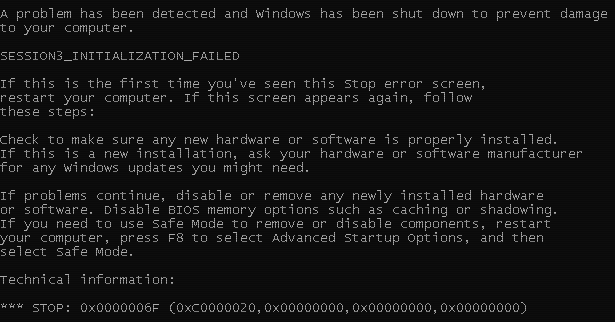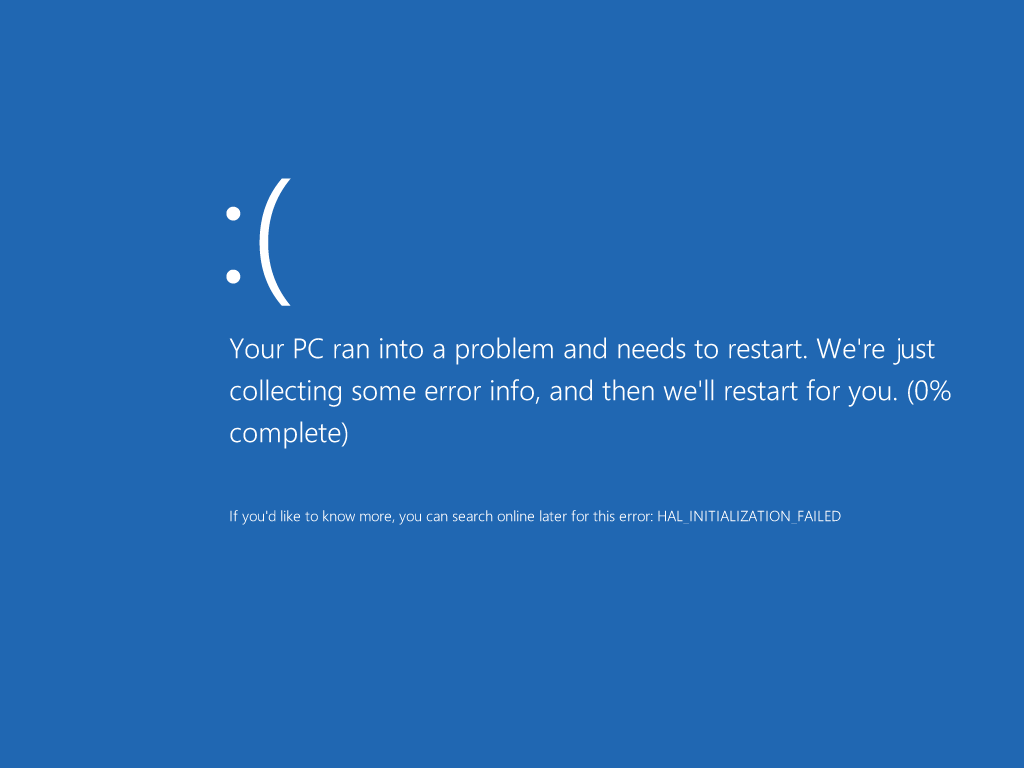| Nos esforzamos para localizar nuestro sitio web en tantos idiomas como sea posible, sin embargo, esta página no está traducida máquina usando Google Translate. | cerca |
-
-
productos
-
recursos
-
soporte
-
empresa
-
Una guía para la “Sesión 3 No se pudo inicializar” pantalla azul de la muerte de errorA Guide to the “Session3 Initialization Failed” Blue Screen of Death Error
Por Steve Horton Julio 02, 2013Blue Screen of Death, bsod, SESSION3_INITIALIZATION_FAILEDNo hay comentariosERROR NOMBRE: SESSION3_INITIALIZATION_FAILED
CÓDIGO DE DETENCIÓN: 0x0000006F
Tienes una Pantalla azul de la muerte, llamada Inicialización de sesión3 fallida, que a veces se muestra con un código de detención de 0x0000006F. Has venido al lugar correcto. Cada vez que encuentre este error en particular, significa que su computadora no puede leer un archivo vital necesario para el lanzamiento de Windows. Esto normalmente ocurre durante la instalación, reinstalación o reparaciones. Puede ser causado por cualquier cosa, desde un disco rayado hasta sectores defectuosos en un disco duro: es un gran problema, y si tiene suerte, aquí encontrará una solución inmediata. Si no es así, es posible que deba llamar a un técnico o a su fabricante para reemplazar su hardware defectuoso.

Cómo se ve este error en las versiones de Windows anteriores 8.
Algo así como lo que parece en Windows 8.Este error puede ser causado por una mala instalación de CD / DVD, una mala unidad de disco, un disco duro defectuoso o una RAM defectuosa. Si se trata de una instalación de reparación o actualización, también puede ser causada por Windows ReadyBoost o archivos dañados del sistema operativo que ya están en su computadora.
Si tiene un disco de instalación defectuoso, simplemente intente usar otro. Si su computadora ya tiene otro sistema operativo ejecutándose, también puede intentar instalar Windows usando una unidad flash USB .
Si tiene una unidad óptica defectuosa, tiene un problema. Porque si se trata de una instalación nueva, es posible que no tenga forma de comprobar si es o no el origen del problema. Si ya no tiene un sistema operativo en su computadora, no podrá determinar si la unidad es la culpable, pero si lo hace, simplemente intente usar otro disco y vea si se lee correctamente.
Si tienes un disco duro defectuoso, vas a necesitar iniciar desde tu disco de Windows o un Disco de Recuperación . Cuando se le solicite, vaya a la Consola de recuperación o al Símbolo del sistema (según la versión de Windows). Una vez allí, utiliza chkdsk para intentar reparar tu unidad dañada. Para usar chkdsk, escriba chkdsk C: / r en Windows XP, o chkdsk C: / f en otras versiones de Windows. Reemplace C: con la letra de su unidad, si instaló Windows en una unidad con una letra diferente.
Si tiene RAM defectuosa, solo necesita reemplazarla. Póngase en contacto con su fabricante o cómprese un reemplazo, ya sea que funcione.
Si ya ha hecho todo esto y aún tiene problemas, probablemente deba recurrir al Soporte Técnico o al fabricante, ya que le han dado una máquina defectuosa.
Was this post helpful?YesNoGratis Actualizaciones de controladores
Actualiza tus drivers en menos de 2 minutos para disfrutar mejor rendimiento de la computadora - Gratis.
Gratis Actualizaciones de controladores
Actualiza tus drivers en menos de 2 minutos para disfrutar mejor
rendimiento de la computadora - Gratis.
¿No ha encontrado la respuesta?Haz una pregunta a nuestra comunidad de expertos de todo el mundo y recibir una respuesta en ningún momento a todos.most relevant artículos recientes Copyright © 2026 Corel Corporation. Todos los derechos reservados. Términos de Uso | Privacidad | CookiesFijarlo en Pinterest